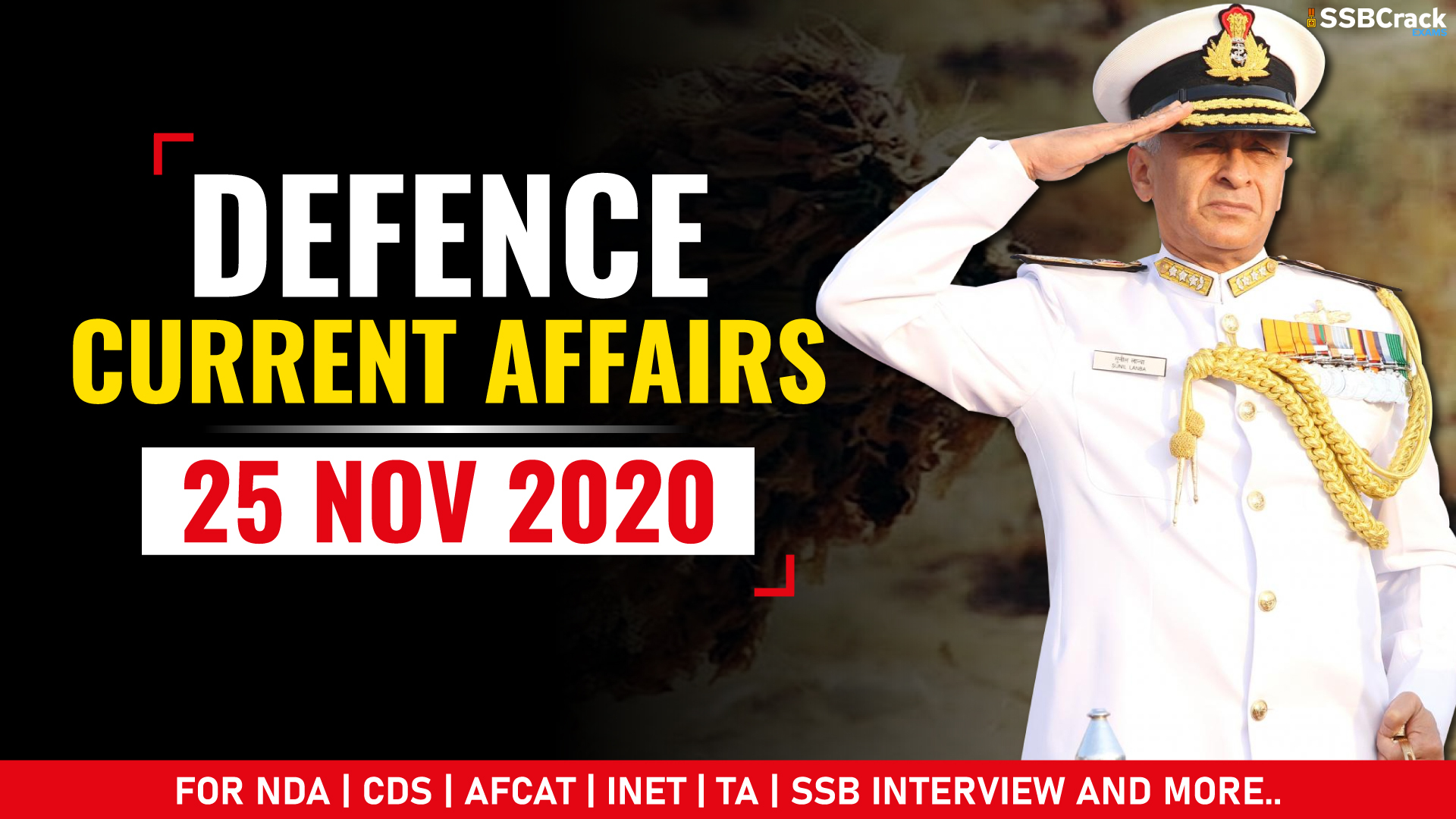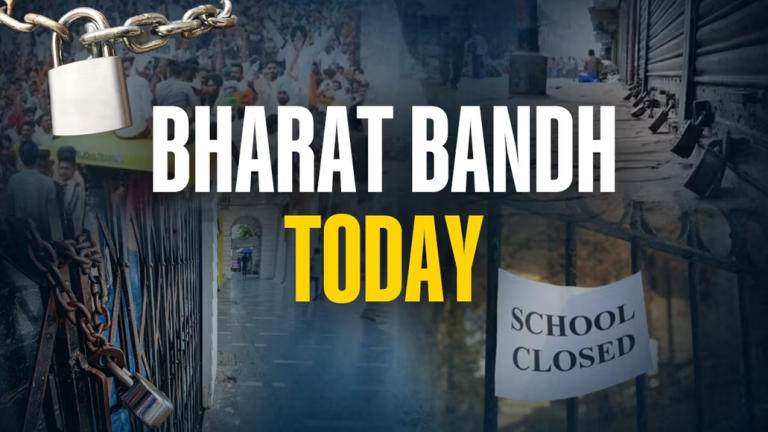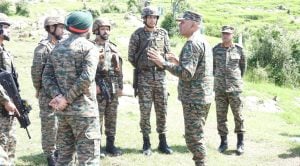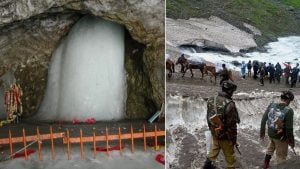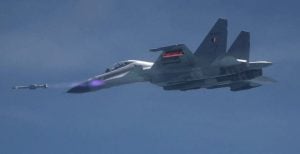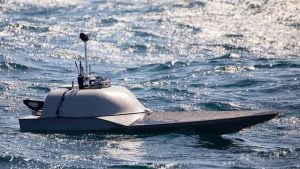Army Chief Reviews Security Situation in North Eastern Region
- Chief of Army Staff General Manoj Mukund Naravane arrived at Dimpaur, Nagaland on Monday, 23 November 2020 on a three days visit to review the security situation in North East Region. On arrival at Dimapur, the Army Chief was briefed by Lieutenant General Anil Chauhan, General Officer Commanding in Chief, Eastern Command and Lieutenant General R P Kalita GOC Spear Corps on operational preparedness along the Northern borders as well as operations in hinterland of Assam, Nagaland, Manipur and Arunachal Pradesh. The COAS was also briefed on the progress of the ongoing Naga Peace talks.
- On 24 November, the COAS visited various Army and Assam Rifles Headquarters in Nagaland and Manipur to make a firsthand assessment of the ground situation. The COAS interacted extensively with the troops deployed in the remote areas and appreciated their state of operational preparedness, morale and conduct of people friendly operations. Later in the evening, General Naravane called on the Hon’ble Governor of Nagaland, Mr RN Ravi and Chief Minister, Mr Neiphiu Rio to discuss prevailing security situation in the State and assured the wholehearted support of the Army and Assam Rifles in maintaining peace and tranquility in the state and ensuring security along the Indo-Myanmar border.
- As part of Indian Army’s efforts in contributing towards development and equitable opportunities to all sections of the society, a new residential facility at Kohima Orphanage to be run by Assam Rifles will be inaugurated by the COAS on 25 November 2020 prior to his return to New Delhi.
H.E. Barry O’ Farrell AO, High Commissioner of Australia calls on FOC-in-C, Western Naval Command
- H.E. Barry O’ Farrell AO, High Commissioner of Australia, accompanied by Ms. Sarah Roberts, acting Consul General, Consulate of Australia, Mumbai and a three member delegation called on Vice Adm Ajit Kumar, Flag Officer Commanding-in-Chief, Western Naval Command on 23 Nov 20. The High Commissioner interacted with the Admiral and exchanged views on various issues of common interest such as Bilateral Cooperation in Defence and Security, Strategic Partnership and shared maritime interests as Indian Ocean littoral States. The High Commissioner also visited the Aircraft Carrier Dock at the Western Naval Command.
- The High Commissioner’s visit was significant as it coincided with the recently concluded Quad exercise MALABAR 2020 in which India, Australia, Japan and the U.S. participated. HMAS Ballarat, a frigate of Royal Australian Navy represented Australia in both the phases of Malabar 20 and had spent some time at Goa port for its operational turnaround from 10 – 13 Nov 20.
- The current visit by the High Commissioner is in accordance with the good relations enjoyed by both the Commonwealth nations and is expected to further strengthen the existing bonds between both the navies.
India now working on 1,500-km range BrahMos supersonic cruise missile
- India Tuesday began a series of tests of the BrahMos supersonic cruise missile, even as work goes on to extend its range. India is working on a 1,500-km range version of the system that can be launched from land, water or air.
- BrahMos, the only supersonic cruise missile in the world that flies at three times the speed of sound (2.8 Mach), currently has a range of 290 km, but efforts are also on to extend this to 400 km.
- The Army carried out the first of several ‘live missile tests’ of the 290-km range BrahMos in the Andaman and Nicobar Islands. The Navy and the Air Force — which has fitted its Sukhoi Su-30 MKI fighters fitted with the BrahMos — are also likely to carry out tests this week.
- Sources in the defence and security establishment said the test of the 400-km range of BrahMos conducted in September was successful, and talks are on with the three Services to extend the range of the missiles within a scheduled time.
- A hypersonic version of the missile — which flies at over five times the speed of sound — is also being worked upon, and sources said the target is to test an 800-km range BrahMos next year.
- “The team is also working on a 1,500-km range missile,” a source said, adding that initially, this will be a land-based missile.
- “But once the system is proven, it will need just some modifications to fire from the air and water,” the source said.
- The Indian Air Force had, in January this year, commissioned the 222 ‘Tiger Sharks’ squadron in Thanjavur, home to the first lot of Su-30 MKIs equipped with the BrahMos.
- The BrahMos missile is the product of a joint venture between India’s Defence Research and Development Organisation and Russia’s NPO Mashinostroyeniya in 1998. It is a portmanteau of the names of two rivers — India’s Brahmaputra and Russia’s Moskva.
- The BrahMos missile has a maximum speed of 2.8 Mach (around 3,450 kmph or 2,148 mph) and is difficult to intercept by surface-to-air missiles currently deployed from warships across the world. It also has immense ability to evade various radars.
- The missile’s cruising altitude could be up to 15 km, and the lowest it can fly is 10 metres above the surface. The missile is capable of carrying a conventional warhead (non-nuclear) weighing 200-300 kg.
- The BrahMos is a two-stage missile, with a solid propellant booster engine that kicks in in the first stage and brings the missile to supersonic speed before separating. Following this, the liquid ramjet comes into action, and takes the missile closer to Mach 3 in cruise phase. It operates on a ‘fire and forget’ principle — it doesn’t have to be constantly monitored on its way to the target.
First batch of “Made in India” ALH ‘Dhruv’ Mk-III helicopters ready for delivery for Navy & Coast Guard
- The first batch of the “made in India” Mark-III variant “Dhruv” Advanced Light Helicopter (ALH) customized for coastal security is slated for delivery to Indian Navy (IN) and Indian Coast Guard (ICG) shortly. This is a landmark event for both sides, being the first bulk order of the Dhruv Mk-III placed on state-owned Hindustan Aeronautics Limited (HAL) by the two services.
- While the Indian Army and Air Force have inducted later versions of ALH (Mk-III utility, and weaponized Mk-IV “Rudra”) in large numbers, the IN and ICG have thus far operated only older Mk-I variant with conventional cockpit and Turbomeca (now Safran Helicopter Engines) TM 333 2B2 turboshaft engines.
- The customized Mk-III under delivery features a full glass cockpit with HAL’s Integrated Architecture Display System (IADS), more powerful “Shakti” (Safran Ardiden 1H1) engines, and a host of new systems integrated by HAL’s Rotary Wing Research and Design Centre (RWRDC). Two “green” helicopters were handed over to RWRDC by HAL’s Helicopter Division in June 2018 for system integration. The work was completed briskly by HAL in under two years before Covid-19 lockdowns put the brakes on field trials.
- After the lockdown restrictions were gradually lifted by Indian government in May 2020, sensor integration and sea trials resumed at Kochi, Chennai and Goa on the first of ICG and IN airframes. As of November, two helicopters churn the air above Bengaluru almost daily for customer training. Acceptance flights by HAL test crew were in progress when this author visited, with the first lot expected to be formally “signaled out” for customer acceptance sorties at the end of November.
- The contract for 32 coastal security ALH was inked in March 2017 with ICG as the lead service. The IN order for 16 — to supplement its ageing and depleting fleet of Alouettes (Chetaks) — was dovetailed into this program based on the overarching responsibility for coastal security placed on it by the government of India in the wake of 26/11 (2008) terrorist attacks on Mumbai.
- These helicopters (yet to be christened with a unique Indian name) come with latest-generation avionics and role equipment. The helicopters are primarily meant for use in a shore-based role. However, HAL is confident that the rotors will be ready to embark ships should the need arise.
- The ICG contract, for instance, directs HAL to test and provide an afloat envelope (SHOLs) for the Mk-III. It also includes a performance-based logistics (PBL) clause — making this the first time a customized variant with tough PBL clause is being offered by HAL to a sea-going customer. (The IN contract does not have PBL built-in, possibly to keep within budget constraints while letting ICG test the waters.)
- The selection of systems and customization was done primarily in consultation with ICG. For its coastal security role, the aircraft has a nose-mounted surveillance radar with 270-degree coverage that can detect, classify and track multiple marine targets; it has synthetic-aperture radar, inverse synthetic-aperture radar, and moving target indication classification functions, including weather mode.
- There is also a multi-spectral electro-optic (EO) pod for reconnaissance, surveillance, target acquisition and range finding with stowable control grip on co-pilot side.
- Other features include a removable medical intensive care unit for the air ambulance role; high-intensity searchlight, loudhailer, 12.7-mm cabin-mounted machine gun (with provisions on the left side), traffic alert and collision avoidance system, V/UHF communication system with data modem, IFF Mk-XII with Mode S transponder, automatic identification system, automatic deployable emergency location transmitter, solid state digital video recorder, pressure refueling system, 360-degree search-and-rescue homer with coverage from 110-410 MHz, electrical rescue winch with rescue basket for double-lift (250 kilograms/550 pounds), control grip (winchman mini-stick) in cabin for air-sea rescue, and upgraded IADS and automatic flight control system software.
- Such an array of systems was hitherto seen only on heavier, multi-role helicopters of the Indian Navy. For instance, no light helicopter in the IN’s inventory ever featured a glass cockpit, surveillance radar or EO pod. The helicopter bears a “fully loaded” look. The maximum certificated all-up weight has been revised to 5,750 kg (12,675 lb.) from the earlier Mk-I variant of IN and ICG that weighed in at 5,500 kg (12,125 lb.).
- Folded dimensions, a cumbersome blade-folding procedure, performance and maintainability issues plagued afloat exploitation of the eight limited-series production ALH Mk-I in naval inventory since their induction in 2003. The ICG holds four ALH Mk-I in its inventory, again with no integral ship flight.
- Six of the 16 naval Mk-III ALH are to be equipped with an indigenous low frequency dunking sonar (LFDS) developed by Kochi-based Naval Physical and Oceanographic Laboratory. The sonar’s units are being produced by state-owned Bharat Electronics Limited with a host of sub-vendors downstream. Earlier this decade, the navy had offered a Mk-I naval ALH as test bed for developmental trials of the LFDS (this author was fortunate to participate in ground and flight trials of the LFDS).
- Sources indicate that the IN views the coastal security ALH and Naval Utility Helicopter (NUH) programs differently. Seamless deck interface and a seagoing, light multi-role helicopter under 4.5 tonnes drives the navy’s flagship NUH program, sought to be delivered through a strategic partnership between an Indian OEM and foreign partner under the “Make in India” initiative.
- HAL hopes to deliver five coastal security ALH Dhruv Mk-III helicopters by the end of November 2020, another nine by March 2021, and the balance 18 helicopters by September 2021 — a tough task given HAL’s order book and the changed situation post-COVID-19.
Govt. Approves Joint Military Logistics Nodes in Run-Up to Theatre Commands
- The government has now formally approved the first set of joint structures to handle logistics in the 15-lakh strong armed forces, in a step towards injecting some desperately-required integration among the three Services and the eventual creation of unified theatre commands.
- The government has now formally approved the first set of joint structures to handle logistics in the 15-lakh strong armed forces, in a step towards injecting some desperately-required integration among the three Services and the eventual creation of unified theatre commands.
MHA unearths ₹1000cr hawala ring run by PLA in India
- The Ministry of Home Affairs (MHA) has unearthed Rs 1000 crore hawala ring run by China’s People’s Liberation Army (PLA) in India.
- According to a report, the arrested Chinese agents were getting help from existing entrenched Pakistani spy ring to establish their networks in India.
- This development comes after the Delhi Police arrested Luo Sang, alias Charlie Peng, who is suspected to be an agent of the Chinese intelligence service, the Ministry of State Security (MSS) In August.
- The crackdown on a multi-billion hawala racket operating in Delhi-NCR revealed that Luo Sang had created fake Indian identity of Charlie Peng through forged Aadhaar cards and travel documents. He was earlier arrested by Delhi Police on charges of espionage in 2018.
- Sang was first sent to Nepal where he was trained in money exchange, hawala operations and accounts after which he arrived in India.
- As per the reports, he was collecting information on whereabouts of key Tibetan refugees and people close to Dalai Lama in India.
- In September 2018, the Delhi Police’s Special Cell arrested Luo Sang on charges of running a spy ring in India and seized a forged Indian passport which he had procured from Manipur.
- During interrogation, he revealed that he had crossed into India in 2013 and first settled in Manipur where he married Indian women and the duo started living in rented accommodation. After staying for a few years in Manipur he shifted his base to Delhi.
- Further investigations revealed that Sang had created more than 40 bank accounts linked to multiple shell companies and the hawala operations were linked to transactions worth over Rs 1,000 crore.
- The China-Pakistan axis has been a serious cause of concern for India and Indian intelligence agencies.
- In June this year, Research and Analysis Wing (R&AW) said it was bolstering up its maritime intelligence network with increased focus on the Arabian Sea region to counter the growing influence of China-Pakistan nexus in the Indian Ocean.
QUICK REVIEW
- On 24 November 2020, the COAS visited Assam Rifles Headquarters situated in _____ to make a firsthand assessment of the ground situation.
- Dimapur, Assam
- Kohima, Nagaland
- Shillong, Meghalaya
- Agartala, Tripura
ANSWER: C
- Yesterday, Army tested Brahmos, as a part of user training exercise, that demonstrated how many waypoint curve maneuvers to avoid interception by air defence systems?
- Six
- Five
- Four
- Three
ANSWER: D
- ALH Dhruv Mk. III features a full glass cockpit with Integrated Architecture Display System (IADS) developed by
- Indian Air Force
- National Aeronautics Limited
- Hindustan Aeronautics Limited
- Defence Research & Development Organization
ANSWER: C
- 6 of the 16 naval Mk-III ALH are to be equipped with an indigenous low frequency dunking sonar (LFDS) developed by
- Naval Physical and Oceanographic Laboratory
- Indian Naval Architecture Establishment
- Garden Reach Shipbuilders & Engineers Ltd.
- Hindustan Shipyard Limited
ANSWER: A
- The LFDS sonar’s units of ALH Mk. III are being produced by which state-owned company with a host of sub-vendors downstream?
- Bharat Heavy Electricals Limited
- Bharat Electronics Limited
- Bharat Earth Movers Limited
- Bharat Sanchar Nigam Limited
ANSWER: B


